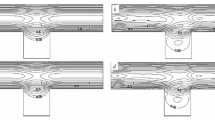Abstract
The hydrodynamic aspects of functioning of a high-voltage infiltration nanogenerator employing the potential energy of a liquid entering a glass filter are considered. This energy transforms into electric energy due to the formation of a double electric layer owing to the triboeleсtrification effect during the infiltration of the dielectric liquid through the porous structure. To solve the emerged problems, two local effective parameters were introduced in the equations of a hydrodynamic flow along the infiltration path: mechanic density and dynamic viscosity. The working equations for the motion of the liquid were derived; the solutions for the velocity and the flow rate that determine the electric characteristics of a nano-generator—the electric charge and potential as well as their physical relationships—were obtained.




Similar content being viewed by others
REFERENCES
Ravelo, B., Duval, F., Kane, S., and Nsom, B., Demonstration of the triboelectricity effect by the flow of liquid water in the insulating pipe, J. Electrostat., 2011, vol. 69, no. 6, p. 473. https://doi.org/10.1016/j.elstat.2011.06.004
Sasaki, A. and Uchiyama, S., Generation of static electricity during oil filtration, Lubr. Eng., 1999, vol. 55, no. 9, p. 14.
Wang, S., Lin, L., Xie, Y., Jing, Q., et al., Nano Lett., 2013, vol. 13, p. 222. https://doi.org/10.1021/nl400738p
Sripadmanabhan Indira, S., Aravind Vaithilingam, C., Satya Prakash Oruganti, K., Mohd, F., and Rahman, S., Nanogenerators as a sustainable power source: state of art, applications, and challenges, Nanomaterials, 2019, vol. 9, no. 5, p. 773. https://doi.org/10.3390/nano9050773
Park, H.-Y., Kim, H.K., Hwang, Y.-H., and Shin, D.‑M., Water-through triboelectric nanogenerator based on Ti-mesh for harvesting liquid flow, J. Korean Phys. Soc., 2018, vol. 72, no. 4, p. 499. https://doi.org/10.3938/jkps.72.499
Kozhevnikov, I.V., Bologa, M.K., Grosu, F.P., et al., A high voltage nanogenerator based on electrification of the dielectric liquid flow through the glass filter, Surf. Eng. Appl. Electrochem., 2021, vol. 57, no. 4, p. 495.
Zhakin, A.I., Electrification of low-conductivity liquids in laminar flow through tubes and capillaries, J. Appl. Mech. Tech. Phys., 1982, vol. 23, no. 6, p. 622.
Contact electrification, Chemistry and chemical technology, Handbook of chemist 21. http://chem21.info/info/476791.
Loeb, L.B., Static Electrification, Berlin: Springer-Verlag, 1958.
Schlichting, H., Grenzschicht-Theorie, Karlsruhe: G. Braun Verlag, 1951.
Landau, L.D. and Lifshitz, E.M., Course of Theoretical Physics, Vol. 6: Fluid Mechanics, Oxford: Pergamon, 1987.
Author information
Authors and Affiliations
Corresponding author
Ethics declarations
The authors declare that they have no conflict of interests.
Additional information
Translated by M. Myshkina
About this article
Cite this article
Grosu, F.P., Bologa, M.K. & Kozhevnikov, I.V. Hydrodynamic Aspects of a High-Voltage Infiltration Nanogenerator. Surf. Engin. Appl.Electrochem. 57, 558–566 (2021). https://doi.org/10.3103/S1068375521050033
Received:
Revised:
Accepted:
Published:
Issue Date:
DOI: https://doi.org/10.3103/S1068375521050033




